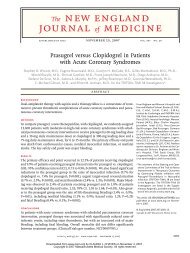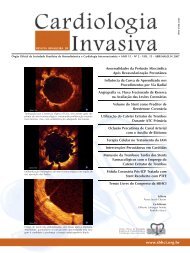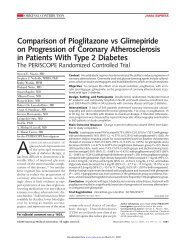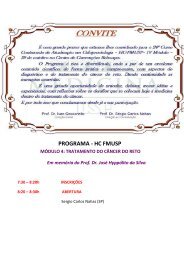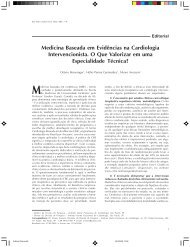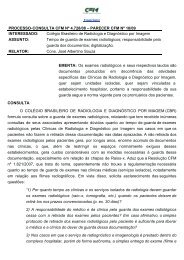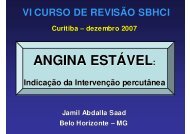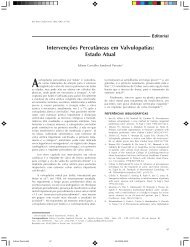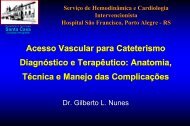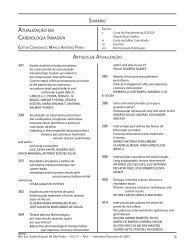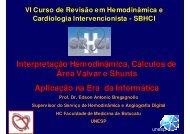iii FEBRE REUMÁTICA
iii FEBRE REUMÁTICA
iii FEBRE REUMÁTICA
You also want an ePaper? Increase the reach of your titles
YUMPU automatically turns print PDFs into web optimized ePapers that Google loves.
GUILHERME L<br />
e cols.<br />
Etiopatogenia da<br />
febre reumática<br />
REFERÊNCIAS<br />
PATHOGENESIS OF RHEUMATIC FEVER<br />
AND RHEUMATIC HEART DISEASE<br />
LUIZA GUILHERME, KELLEN C. FAÉ, JORGE KALIL<br />
1. Baggenstoss AH, Titus JL. Rheumatic and collagen<br />
disorders of the heart. In: Gould SE, ed. Pathology<br />
of the heart and blood vessels. 3 rd ed. Springfield,<br />
Illinois: Charles C. Thomas Publisher; 1968. p. 649-<br />
722.<br />
2. Fischetti VA. Streptococcal M protein. Sci Am.<br />
1991;264(6):58-65.<br />
3. DiSciascio G, Taranta A. Rheumatic fever in children.<br />
Am Heart J. 1980;99:635-58.<br />
4. Clarke CA, McConnell RB, Sheppard PM. ABO blood<br />
groups and secretor character in rheumatic carditis.<br />
Br Med J. 1960;1:21-3.<br />
5. Falk JA, Fleischman JL, Zabrieski JB, Falk RE. A<br />
study of HL-A antigen phenotype in rheumatic fever<br />
and rheumatic heart disease. Tissue Antigen.<br />
Rheumatic fever occurs as a delayed sequel of throat infection by Streptococcus<br />
pyogenes, affecting 3-4% of untreated children. Genetic susceptibility is associated<br />
with HLA class II alleles. Rheumatic fever patients presented an exacerbated humoral<br />
and cellular response against streptococci antigens that by similarities between<br />
the bacteria and host antigens, leads to heart tissue injury by a mechanism called<br />
molecular mimicry. The mitral and aortic valves are the tissue most affected. Our<br />
group has described by the first time the immunodominant segment of streptococci<br />
M5 protein (81-96 amino acid residues) and some heart tissue derived proteins that<br />
are simultaneously recognized by peripheral T cells and heart infiltrating T cell clones<br />
by molecular mimicry, mainly by HLA DR7 and DR53 rheumatic fever/rheumatic<br />
heart disease patients. Mononuclear cells that infiltrated the heart lesions produced<br />
essentially inflammatory cytokines (INFγ and TNFα). Interestingly, mononuclear cells<br />
from the valvular lesions presented scarce numbers of IL-4 positive cells, suggesting<br />
that the most severe lesions present in the valves are due to low numbers of<br />
cells producing the regulatory IL-4 cytokine. In conclusion, all the knowledge acquired<br />
in the pathogenesis of rheumatic fever/rheumatic heart disease defines rheumatic<br />
fever/rheumatic heart disease as a post-infection auto-immune disease mediated<br />
by cross reactive T cells and inflammatory cytokines.<br />
Key words: rheumatic fever, rheumatic heart disease, molecular mimicry, T lymphocytes,<br />
cytokines.<br />
(Rev Soc Cardiol Estado de São Paulo. 2005;1:7-17)<br />
RSCESP (72594)-1502<br />
1973;3:173-8.<br />
6. Ayoub EM, Barrett DJ, MacLaren NK, Krischer JP.<br />
Association of class II histocompatibility leukocyte<br />
antigens with rheumatic fever. J Clin Invest.<br />
1986;77:2019-26.<br />
7. Anastasiou-Nana M, Anderson JL, Carlquist JF, Nanas<br />
JN. HLA-DR typing and lymphocyte subset evaluation<br />
in rheumatic fever and rheumatic heart disease:<br />
a search for immune response factors. Am Heart<br />
J. 1986;112:992-7.<br />
8. Rajapakse CN, Halim K, Al-Orainey I, Al-Nozha M,<br />
Al-Aska AK. A genetic marker for rheumatic heart<br />
disease. Br Heart J. 1987;58(6):659-62.<br />
9. Bhat MS, Wani BA, Koul PA, Bisati SD, Khan MA,<br />
Shah SU. HLA antigen pattern of Kashmiri patients<br />
with rheumatic heart disease. Indian J Med Res.<br />
1997;105:271-4.<br />
Rev Soc Cardiol Estado de São Paulo — Vol 15 — N o 1 — Janeiro/Fevereiro de 2005 15



